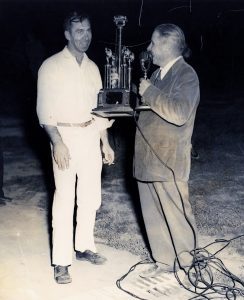INDIANAPOLIS – Impossible.
That’s the only way to describe the likelihood of an off-the-wall racing idea turning into one of the greatest events in motorsports and enduring for an unthinkable four generations.
The Lucas Oil Little 500 will see its 75th running this May, reaching a mark almost unheard of in auto racing. For an event to prevail through 75 annual outings is so unlikely it’s difficult to find anything to compare it to. But prevail has been the word, as the Little 500 has survived countless ups and downs and challenges.
The concept of the race — 33 cars on a quarter-mile track, lined up in 11 rows of three, with 500 laps to go — was an idea pitched in the spring of 1949 by track owner Joe Helpling and his young PR man, Bob Hopkins. They sensed the racing at Indiana’s Sun Valley Speedway — now Anderson Speedway — had grown stale, and they were looking to spice things up with something new and different, something compelling, something audacious.

The original race featured roaring roadsters, and those guys initially protested that the concept was — impossible. No cars — or drivers — could withstand a 500-lap grind. But the race went off without a hitch, with Sam Skinner winning and 24 cars finishing the race. By the mid-1950s the roadsters had faded into history and sprint cars took over, but the event continued.
Across nine wide decades the Little 500 has touched countless lives. It has inspired a passionate following, many inheriting their love for the event from fathers, grandfathers and uncles. It continues to be one of most compelling racing events on the planet, two hours of non-stop chaos and excitement.
Racing people have a habit — and a history — of mucking up a good thing. Think about it: Tracks that were once successful slip toward failure, series that were booming fade into irrelevance and great events fall from favor and disappear. Too often, leaders can’t seem to resist the urge to “improve” things, abandoning principles and traditions in search of something more trendy or “cool.”
But the Little 500 remains firmly intact — 33 cars, 11 rows of three, 500 laps to go — and that is a great credit to the three entities that have operated Anderson Speedway since the beginning.
Helpling started the race and nurtured his baby with great love and care, pushing it through to 1976. Trackside Associates, a group of local owners, kept the tradition intact through 1997. Rick Dawson, the current owner of Anderson Speedway, has continued on for the past 25-plus years. Bravo, all around. Seriously … bravo, all around.
The Little 500 has definitely weathered some difficult times, particularly as pavement sprint car racing waxed and waned through the years. But they’ve always had enough cars to fill the field of 33, and eventually the pendulum swung back toward pavement and things improved.

The Little 500 is currently in the midst of a strong run. Grandstand tickets have been nearly sold out, which is a significant accomplishment these days. There is a healthy buzz during the weeks leading up to the event and everyone — fans, racers, sponsors and track officials — brings a bona fide excitement into the week leading to Memorial Day.
A lot of this is based on tradition. The Little 500 is the type of event where people — across generations — know exactly where they will be on the Saturday of Memorial Day weekend. They arrive early and mix and mingle, slipping to their seats as pre-race ceremonies begin. The hair on their neck rises and their breath quickens as trucks begin to push the cars to life. They stand as the field comes to the green flag and for the next two hours their eyes, ears and nose take in more than the brain can process.
It’s all very wonderful and I highly recommend it to everyone.
All those years ago, before razor blades and a driver’s license, I was a kid sitting in those stands. In the final few minutes before the race started, I was beyond excited, and I would glance out toward the streets surrounding the track. Vehicles rode up and down Pendleton Avenue and 29th Street, coming and going, apparently oblivious to what was about to happen.
“How can that be?” I wondered. “How could anyone not want to be sitting in these stands, ready to watch the Little 500? Why would anyone want to be anywhere else?”
It’s a mystery I still don’t understand. I’ll see you at Anderson Speedway on Saturday night, May 27, for the 75th Lucas Oil Little 500.
Bring earplugs.
This story appeared in the March 15, 2023 edition of the SPEED SPORT Insider.

